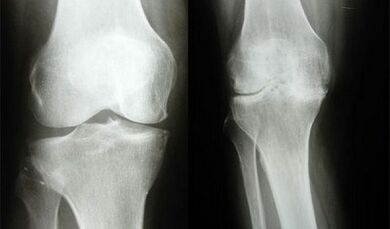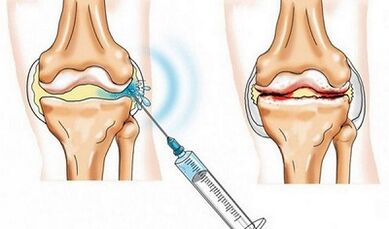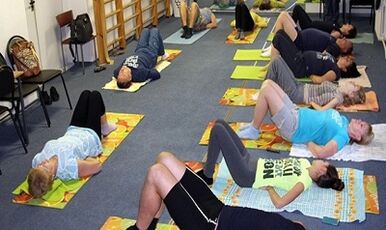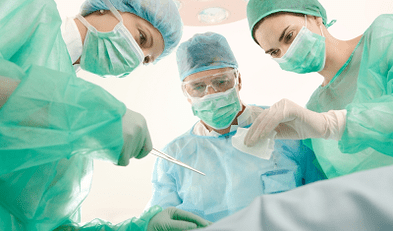
One of the most common pathologies of the musculoskeletal system is knee joint arthrosis (otherwise gontrosis) is a chronic disease accompanied by dystrophy and the destruction of articular structures in the knee.
The result of destructive processes is a sharp limit or complete loss of joint mobility, and as a result - decreased performance, disability.
Negative results can only be avoided if you have early diagnosis and timely therapy.
Causes
By origin, knee arthrosis is primary and secondary.Primary develops as an independent disease, more often diagnosed in older people and in this case is caused by age -related changes that occur in the tissues.Medium gonarthrosis results in other diseases and disorders in the body.
The development of gonarthrosis promotes:
- Injuries (dislocation, fractures, pelvic injury);
- Diseases of the musculoskeletal system (congenital deformity of the legs, knee dysplasia, chondrocalcinosis, arthritis, osteoporosis);
- Constant high loads on funds, professional activities, professional sports;
- Excess weight, obesity;
- Endocrine diseases, including diabetes, hypothyroidism, acromigaly;
- Metabolic disorders;
- Genetic predisposition.
Symptoms
Inflammation with knee joint arthrosis is accompanied by two major clinical manifestations - pain and swelling.The intensity and frequency of the appearance of the pain depends on the depth of damage to the joint structures.In the early stages, the pain is felt only by load, quickly passing during rest.With advanced gonarthrosis, painful pain is permanently encountered, intense during movements, with weather changes.
Other signs of knee joint arthrosis:
- When moving;
- Strength in the joint, impaired motor function;
- Knee deformity (neglected gonarthrosis).
Gonarthrosis may be accompanied by synovitis (accumulation of fluid in the joint) and subsequent formation of a baker cyst (elastic formation of the back of the knee).
The degree of arthrosis

Symptoms of knee joint arthrosis vary in depth of damage to the knee structures and therefore are distinguished in 3 stages of pathology.
- Knee joint arthrosis 1 degreeIt is manifested by weak pain (at the same time resting), with a slight severity after sleep.In the radiographic picture, there is a minor narrowing of the joint gap (less than a third), with single osteophytes (bone results).
- Knee joint arthrosis 2 degreesIt is accompanied by pain and characteristic of crunchy movements.The pain has been maintained for some time.In the morning firmness, the amplitude of the movements is marked.Diagnostic procedures show a joint gap (more than half) and pronounced narrowing of multiple osteophytes.
- Knee arthrosis 3 degreesIt is accompanied by persistent painful pain that occurs extensively during movements and at night.Morning firmness remains for more than an hour, exacerbated by inflammation and for at least half an hour - during remission.Joint mobility is dramatically limited or completely lost.In the radiographic picture, multiple large osteophytes, cysts are seen.The joint gap is narrow than two -thirds of the norm.
Depending on the degree of arthrosis of the knee joint, the patient is prescribed conservative or surgical treatment.
Diagnostics
Diagnosis of knee joint arthrosis includes visual examination, patient complaints, laboratory tests (urine analysis, general and biochemical blood tests), and instrumental examination methods.
The following diagnostic procedures allow you to confirm or reject the diagnosis:

- Radiography;
- Ultrasound (ultrasound);
- MRI (magnetic resonance imaging);
- CT (computed tomography);
- Arthroscopy and scintigraphy (with tumor suspicions).
Using these methods, the degree of joint gap, cartilage decrease and deformation, fluid in the joint, structural changes in the synovial membrane, increased osteophytic osteophytic osteophytic focus.
Conservative treatment
Conservative treatment methods can reduce pain and inflammation, improve blood circulation and nutrition of the peristate tissues, strengthen the muscle apparatus.
For this they are held:
- Drug therapy;
- Blockade;
- Physiotherapy and manual therapy;
- Medical physical education.
An important component of the treatment of arthrosis is the adherence to a therapeutic diet.
Conservative treatment of knee joint arthrosis will be effective at the initial stage of the disease when small dystrophic cartilage cartridges, inflammation and impaired functions of the synovial vessel are observed.
Medicines
Drug treatment includes an appointment:
- Non -anti -anti -anti -anti -anti -anti -anti -remedies;
- Chondroprotectors;
- Hyaluronic acid.
Nsaid
Non -anti -anti -anti -anti -anti -anti -anti -inflammatory agents help reduce its main symptoms -swelling and pain.
Preparations are prescribed as solutions (for intramuscular administration) or tablets, capsules (for oral administration).Capsules and tablets from the NSAID knee joint arthrosis are taken in short courses, as drugs have a strong irritating effect on the gastric mucosa and can provoke peptic ulcer, many other side effects.
In addition, prescribed external medicines (ointments, gels, creams) based on non -anti -anti -anti -anti -anti -anti -anti -anti -anti -anti -anti -anti -anti -anti -anti -anti -anti -anti -anti -anti -anti -anti -anti -anti -anti -anti -anti -anti -anti -anti -anti -anti -anti -anti -anti -anti -anti -anti -anti -anti -joints components.Local therapy is allowed for a longer time.
NSAIDs have a pronounced anti -anti -anti -anti -action, but prolonged use promotes further destruction of cartilage.
NSAIDs are symptomatic therapy.They help eliminate the unpleasant symptoms of the disease, but do not affect the condition of the cartilage.Unlike these products, chondroprotectors and hyaluronic acid accelerate the processes of regeneration of cartilage tissue and slow down its destruction.
Chondroprotectors
Chondroprotectors' group medicines contain chondroitin and glucosamine (structural cartilage elements) and promote knee joint arthrosis.They are available as tablets, powder for oral cavity, injection solution.
The minimum course of taking tablets and powder is 3 months.After the break, the course is repeated 2-3 times.The course of treatment with the solution includes 12-15 injections, repeated 2-3 times a year.
The first positive results of treatment with chondroprotectors are noticeable just a few months after the onset of therapy.
Hyaluronic acid
Hyaluronic acid is introduced into the affected joint.The treatment of knee arthrosis plays the role of lubrication - the envelope provides articular surfaces, thereby reducing friction between them.
The treatment of therapy with hyaluronic acid helps to increase the elasticity of cartilage tissue, prevents further destruction of articular structures, which improves joint mobility, decreases symptoms of inflammation.Medications tolerate well, do not cause side effects.Their only drawback is the high cost.
The course of treatment with hyaluronic acid usually involves 3-4 injections, which are performed by 10-14 days breaks.
Blockade

If, with non -anti -anti -anti -anti -anti -anti -anti -anti -anti -anti -remedies, knee pain is not released, blockade is carried out -a treatment method in which the drugs are injured directly into the affected tissues to relieve pain and inflammation.Arthrosis therapy is used to block the blockade (injections in the articular cavity) and periarticular (periarticular cavity).
The main advantage of the method is instant deliberate action, as the maximum concentration of such an active ingredient is created precisely in the inflammatory zone.In addition, drugs are not included in systemic blood, which significantly reduces the risk of adverse reactions.
At the next stage of gonartosis, the articular gap is narrow, osteophytes grow, the joint surfaces are deformed, so only perirticular blockade is allowed.
For arthrosis, knee joint blockade can be carried out using anesthetics and corticosteroids.
Anesthetics are usually introduced with steroid hormones to reduce the procedure of pain.
Hyaluronic acid and chondroprotectors can also be introduced directly into the joint.But in this case, we are not talking about blockage, but about intracellular injection, as these medications do not block the impulses of pain, but rather cause cartilage tissue regeneration processes.
Physiotherapy and manual therapy
The main methods of physiotherapeutic effects used in the treatment of arthrosis include:
- Laser treatment;
- Ultrasound therapy;
- Cryotherapy;
- Therapy with paraffin and ozokeritis;
- Mud.
The main task of all physiotherapeutic procedures is to stimulate blood circulation in nearby tissues, improve cartilage nutrition.
Exercise therapy
Pain syndrome forces a patient with gonarthrosis to limit the motor action, resulting in nearby ligaments and muscle atrophy.This condition adversely affects the joint tissues, as the nutrients are infiltrated by synovial fluid during movement.If the joint is constantly rested, the dystrophic processes are exacerbated.

That is why physiotherapy exercises are an integral component of conservative therapy.Moderate physical activity allows you to enhance muscle equipment, strengthen the power of articular structures, eliminate strength and improve knee motor function.
Therapeutic exercises have been developed by the physician individually for each patient, taking into account the depth of the injury and the functional state of the articular structures.
General recommendations for knee joint arthrosis for exercise therapy:
- Start classes only after stopping the signs of acute inflammation;
- Perform all exercises smoothly, without sudden movements;
- The load gradually increases;
- Elimination of high loads of joints (enhanced knee flexibility/extension);
- If there is pain or discomfort, stop exercise.
Diet
With gonarthrosis, products containing: Contains:
- Amino acids (dairy products, low meat varieties);
- Collagen (dishes with gelatin);
- Indistinct fatty acids (vegetable oils, fish);
- Sulfur and selenium (legumes, cereals, cabbage and apples, beef, chicken, eggs).
Also important:
- Eliminate the use of smoked meat, pickles, marinades;
- Restriction of salt consumption;
- Follow 5 times diet;
- Observe the drink mode.
Excess body weight is one of the main factors that provoke knee joint arthrosis.Thus, the task of overweight patients is to reduce body weight.In this case, you will achieve the result only with the help of a diet, as intense sports are harmful to the inflammatory joint.
To reduce body weight, it is advisable to exclude from the menu:
- Fatty varieties of meat and fish;
- Cream, homemade sour cream and other dairy products, with a high percentage of fat content;
- Margarine, mayonnaise, various sauces;
- Confectionery;
- Quick meals;
- Sweet drinks.
Surgical treatment

Knee knee joint arthrosis is not subject to conservative therapy, so surgery is the only solution for the patient.
There are two options for surgical intervention:
- Corrective osteotomy- It is carried out at the initial stage of the stage 3 of gonarthrosis, if the cartilage is partially destroyed, osteophytes may be removed;
- Endoprosthetics- Replacement of the joint or its destroyed parts is performed by complete destruction of the cartilage.
Prognosis
The abnormal changes of joint structures are progressive, irreversible.However, with early diagnosis and proper treatment, you can completely stop the inflammation and stop the dystrophic changes of the cartilage tissue - 1 -grade knee joint arthrosis provides well conservative therapy.
2nd degree arthrosis, accompanied by cartilage destruction and osteophytes, conservative methods allow you to slow down or stop the deformation of cartilage, stop inflammation and improve motor activity.However, doctors often have to resort to blockade, arthroscopy.
It is not possible to cure arthrosis of the knee joint of 3 degrees in a conservative way.The only way to restore knee mobility is surgical intervention.

























